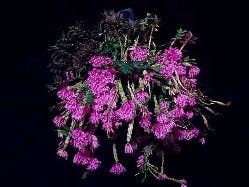
Dendrobium dichaeoides
This wonderful little miniature species hales from the mountains of the island of New Guinea where it grows at altitudes of between 1,000 and 2,000 meters (3,250 to 6,500 feet). It, along with some 80 or so other species, belongs to the Pedilonum section of the genus. This group of species is widely distributed from India to the island of Samoa in the South Pacific but the center of distribution is clearly the island of New Guinea with about 30 species.
First described by Rudolf Schlechter in 1912, Dendrobium dichaeoides (pronounced dick-eh-oh-EE-dees or, more commonly, dick-eh-OY-dees) grows along the margins of montane forest in areas of with high year-round rainfall and high humidity where it will grow into impressive speciments. The pendent stems tightly hug their host tree where their small, overlapping leaves give the plants a mat-like appearance. Most plants produce short canes that run about 12-15cm long (about 5-6 inches) although some clones more than twice that size have been reported. The inflorescences, 4-10 flowered, are produced from near the apex of the cane and flowering in the habitat can occur at any time of the year. The individual flowers are typically about 1cm (about 0.4 inch)long and last for several weeks.

Den. dichaeoides 'Fishing Creek', CCM/AOS Grown by Stephen and Geraldine Male Harrisburg, PA Photo copyright Armand Latour
Because of their sharply pendent habit, the plants are best grown on a mount. Treefern or other water-holding mount is a good choice since the plants should never be allowed to dry out. If you have difficulty growing plants on mounts, this species will respond reasonably well if grown in a hanging pot with a well-drained, yet moisture retentive mix such as sphagnum moss/perlite or tree fern fiber and perlite. This species does best under cool to intermediate conditions with constant, high humidity and year-round watering, although somewhat drier conditions during the dull winter months are beneficial. The optimum light level is dependent on the growing temperatures. The cooler the plants are grown, the more light they will tolerate. Light levels corresponding to bright semi-shade are a minimum for adequate flowering.









